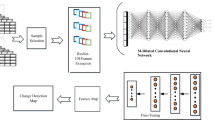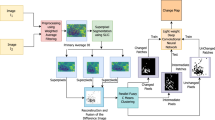Abstract
Automatic change detection is an interesting research area in remote sensing (RS) technology aims to detect the changes in synthetic aperture radar (SAR) and multi-temporal hyperspectral images acquired at different time intervals. This method identifies the differences between the images and accomplishes the classification result into changed and unchanged areas. However, the existing algorithms are degraded due to noises present in the RS images. The main aim of the proposed method is the automatic semantic segmentation based change detection that produces a final change between the two input images. This paper proposes a feature learning method named deep lab dilated convolutional neural network (DL-DCNN) for the detection of changes from the images. The proposed approach consists of three stages: (i) pre-processing, (ii) semantic segmentation based change detection and (iii) accuracy assessment. Initially, preprocessing is performed to correct the errors and to obtain detailed information from the scene. Then, map the changes between the two images with the help of a trained network. The DCNN network performs fine-tuning and determines the relationship between two images as changed and unchanged pixel areas. The experimental analysis conducted on various datasets and compared with several existing algorithms. The experimental analysis is performed in terms of F-score, percentage correct classification, kappa coefficient, and overall error rate measures to show a better performance measure than the other state-of-art approaches.














Similar content being viewed by others
References
Gong M, Zhang P, Su L, Liu J (2016) Coupled dictionary learning for change detection from multisource data. IEEE Trans Geosci Remote Sens 54(12):7077–7091
Jin S, Yang L, Danielson P, Homer C, Fry J, Xian G (2013) A comprehensive change detection method for updating the National Land Cover Database to circa 2011. Remote Sens Environ 132:159–175
Li N, Wang R, Deng Y, Chen J, Liu Y, Du K, Lu P, Zhang Z, Zhao F (2014) Waterline mapping and change detection of Tangjiashan Dammed Lake after Wenchuan Earthquake from multitemporal high-resolution airborne SAR imagery. IEEE Journal of Selected Topics in Applied Earth Observations and Remote Sensing. 7(8):3200–3209
Jia L, Li M, Wu Y, Zhang P, Liu G, Chen H, An L (2015) SAR image change detection based on iterative label-information composite kernel supervised by anisotropic texture. IEEE Trans Geosci Remote Sens 53(7):3960–3973
Li H, Gong M, Wang Q, Liu J, Su L (2016) A multiobjective fuzzy clustering method for change detection in SAR images. Appl Soft Comput 46:767–777
Pham MT, Mercier G, Michel J (2016) Change detection between SAR images using a pointwise approach and graph theory. IEEE Trans Geosci Remote Sens 54(4):2020–2032
Gong M, Zhao J, Liu J, Miao Q, Jiao L (2016) Change detection in synthetic aperture radar images based on deep neural networks. IEEE Transactions on Neural Networks and Learning Systems 27(1):125–138
Gong M, Zhou Z, Ma J (2012) Change detection in synthetic aperture radar images based on image fusion and fuzzy clustering. IEEE Trans Image Process 21(4):2141–2151
Huang L, Fang Y, Zuo X, Yu X (2015) Automatic change detection method of multitemporal remote sensing images based on 2D-Otsu algorithm improved by firefly algorithm. J Sens 2015:1–8
Bazi Y, Bruzzone L, Melgani F (2005) An unsupervised approach based on the generalized Gaussian model to automatic change detection in multitemporal SAR images. IEEE Trans Geosci Remote Sens 43(4):874–887
Celik T (2010) A Bayesian approach to unsupervised multiscale change detection in synthetic aperture radar images. Sig Process 90(5):1471–1485
Gao F, Dong J, Li B, Xu Q, Xie C (2016) Change detection from synthetic aperture radar images based on neighborhood-based ratio and extreme learning machine. J Appl Remote Sens 10(4):046019
Gong M, Su L, Jia M, Chen W (2014) Fuzzy clustering with a modified MRF energy function for change detection in synthetic aperture radar images. IEEE Trans Fuzzy Syst 22(1):98–109
Krinidis S, Chatzis V (2010) A robust fuzzy local information C-means clustering algorithm. IEEE Trans Image Process 19(5):1328–1337
Wu C, Du B, Zhang L (2013) A subspace-based change detection method for hyperspectral images. IEEE Journal of selected topics in applied earth observations and remote sensing. 6(2):815–830
Zhang Y, Du B, Zhang L (2015) A sparse representation-based binary hypothesis model for target detection in hyperspectral images. IEEE Trans Geosci Remote Sens 53(3):1346–1354
Lin M, Tang K, Yao X (2013) Dynamic sampling approach to training neural networks for multiclass imbalance classification. IEEE transactions on neural networks and learning systems. 24(4):647–660
De Morsier F, Tuia D, Borgeaud M, Gass V, Thiran JP (2013) Semi-supervised novelty detection using SVM entire solution path. IEEE Trans Geosci Remote Sens 51(4):1939–1950
Qi Z, Yeh AG (2013) Integrating change vector analysis, post-classification comparison, and object-oriented image analysis for land use and land cover change detection using RADARSAT-2 polarimetric SAR images. In: Advances in spatial data handling, pp 107–123. Springer, Berlin
Alqurashi AF, Kumar L (2013) Investigating the use of remote sensing and GIS techniques to detect land use and land cover change: a review. Advances in Remote Sensing. 2(2):193–204
Deng JS, Wang K, Deng YH, Qi GJ (2008) PCA-based land-use change detection and analysis using multitemporal and multisensor satellite data. Int J Remote Sens 29(16):4823–4838
Khan SH, He X, Porikli F, Bennamoun M (2017) Forest change detection in incomplete satellite images with deep neural networks. IEEE Trans Geosci Remote Sens 55(9):5407–5423
Li P, Chen Z, Yang LT, Zhang Q, Deen MJ (2018) Deep convolutional computation model for feature learning on big data in Internet of Things. IEEE Trans Industr Inf 14(2):790–798
Zhang H, Gong M, Zhang P, Su L, Shi J (2016) Feature-level change detection using deep representation and feature change analysis for multispectral imagery. IEEE Geosci Remote Sens Lett 13(11):1666–1670
Gong M, Yang H, Zhang P (2017) Feature learning and change feature classification based on deep learning for ternary change detection in SAR images. ISPRS Journal of Photogrammetry and Remote Sensing 129:212–225
Mou L, Bruzzone L, Zhu XX (2018) Learning spectral-spatial-temporal features via a recurrent convolutional neural network for change detection in multispectral imagery. IEEE Trans Geosci Remote Sens 57(2):924–935
Wang Q, Yuan Z, Du Q, Li X (2018) Getnet: a general end-to-end 2-D CNN framework for hyperspectral image change detection. IEEE Trans Geosci Remote Sens 57(1):3–13
Vu VT, Gomes NR, Pettersson MI, Dammert P, Hellsten H (2018) Bivariate gamma distribution for wavelength-resolution SAR change detection. IEEE Trans Geosci Remote Sens 57(1):473–481
Zhang Y, Zhang H, Chen X, Liu M, Zhu X, Lee SW, Shen D (2019) Strength and similarity guided group-level brain functional network construction for MCI diagnosis. Pattern Recogn 88:421–430
Jiao Y, Zhang Y, Wang Y, Wang B, Jin J, Wang X (2018) A novel multilayer correlation maximization model for improving CCA-based frequency recognition in SSVEP brain–computer interface. Int J Neural Syst 28(04):1750039
Zhou G, Cichocki A, Zhang Y, Mandic DP (2015) Group component analysis for multiblock data: common and individual feature extraction. IEEE transactions on neural networks and learning systems. 27(11):2426–2439
Zhang Y, Wang Y, Zhou G, Jin J, Wang B, Wang X, Cichocki A (2018) Multi-kernel extreme learning machine for EEG classification in brain–computer interfaces. Expert Syst Appl 96:302–310
Shang R, Yuan Y, Jiao L, Meng Y, Ghalamzan AM (2018) A self-paced learning algorithm for change detection in synthetic aperture radar images. Sig Process 142:375–387
Tian D, Gong M (2018) A novel edge-weight based fuzzy clustering method for change detection in SAR images. Inf Sci 467:415–430
Yang G, Li HC, Yang W, Fu K, Sun YJ, Emery WJ (2018) Unsupervised change detection of SAR images based on variational multivariate Gaussian mixture model and Shannon entropy. IEEE Geosci Remote Sens Lett 16:826–830
Zhang P, Gong M, Su L, Liu J, Li Z (2016) Change detection based on deep feature representation and mapping transformation for multi-spatial-resolution remote sensing images. ISPRS Journal of Photogrammetry and Remote Sensing 116:24–41
Lv N, Chen C, Qiu T, Sangaiah AK (2018) Deep learning and superpixel feature extraction based on contractive autoencoder for change detection in SAR images. IEEE Trans Industr Inf 14(12):5530–5538
Glorot X, Bengio Y (2010) Understanding the difficulty of training deep feedforward neural networks. In: Proceedings of the thirteenth international conference on artificial intelligence and statistics, pp 249–256
Maas AL, Hannun AY, Ng AY (2013) Rectifier nonlinearities improve neural network acoustic models. Proc. icml 30(1):3
Zhan Y, Wang J, Shi J, Cheng G, Yao L, Sun W (2017) Distinguishing cloud and snow in satellite images via deep convolutional network. IEEE Geosci Remote Sens Lett 14(10):1785–1789
Ma L, Li M, Blaschke T, Ma X, Tiede D, Cheng L, Chen Z, Chen D (2016) Object-based change detection in urban areas: the effects of segmentation strategy, scale, and feature space on unsupervised methods. Remote Sensing. 8(9):761
Wu C, Du B, Cui X, Zhang L (2017) A post-classification change detection method based on iterative slow feature analysis and Bayesian soft fusion. Remote Sens Environ 199:241–255
Wu C, Du B, Zhang L (2014) Slow feature analysis for change detection in multispectral imagery. IEEE Trans Geosci Remote Sens 52(5):2858–2874
Canty MJ, Nielsen AA (2008) Automatic radiometric normalization of multitemporal satellite imagery with the iteratively re-weighted MAD transformation. Remote Sens Environ 112(3):1025–1036
Hussain M, Chen D, Cheng A, Wei H, Stanley D (2013) Change detection from remotely sensed images: from pixel-based to object-based approaches. ISPRS Journal of Photogrammetry and Remote Sensing 80:91–106
Author information
Authors and Affiliations
Corresponding author
Additional information
Publisher's Note
Springer Nature remains neutral with regard to jurisdictional claims in published maps and institutional affiliations.
Rights and permissions
About this article
Cite this article
Venugopal, N. Automatic Semantic Segmentation with DeepLab Dilated Learning Network for Change Detection in Remote Sensing Images. Neural Process Lett 51, 2355–2377 (2020). https://doi.org/10.1007/s11063-019-10174-x
Published:
Issue Date:
DOI: https://doi.org/10.1007/s11063-019-10174-x




